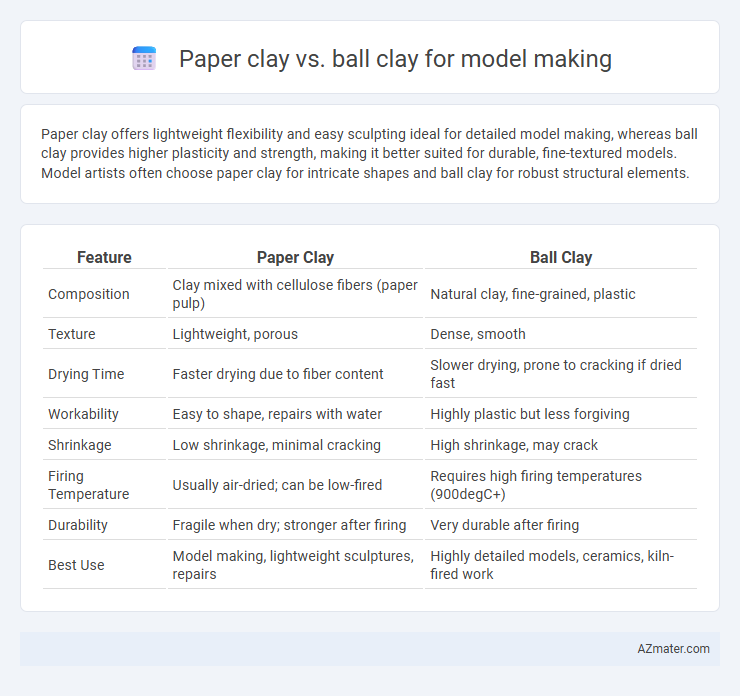Paper clay offers lightweight flexibility and easy sculpting ideal for detailed model making, whereas ball clay provides higher plasticity and strength, making it better suited for durable, fine-textured models. Model artists often choose paper clay for intricate shapes and ball clay for robust structural elements.
Table of Comparison
| Feature | Paper Clay | Ball Clay |
|---|---|---|
| Composition | Clay mixed with cellulose fibers (paper pulp) | Natural clay, fine-grained, plastic |
| Texture | Lightweight, porous | Dense, smooth |
| Drying Time | Faster drying due to fiber content | Slower drying, prone to cracking if dried fast |
| Workability | Easy to shape, repairs with water | Highly plastic but less forgiving |
| Shrinkage | Low shrinkage, minimal cracking | High shrinkage, may crack |
| Firing Temperature | Usually air-dried; can be low-fired | Requires high firing temperatures (900degC+) |
| Durability | Fragile when dry; stronger after firing | Very durable after firing |
| Best Use | Model making, lightweight sculptures, repairs | Highly detailed models, ceramics, kiln-fired work |
Understanding Paper Clay: Composition and Properties
Paper clay consists of ceramic clay mixed with cellulose fibers, typically paper pulp, which enhances its plasticity and drying strength, making it highly suitable for detailed model making. Its porous nature allows for easy joining and repairing of parts even after drying, providing greater versatility compared to conventional clays. Unlike ball clay, which is predominantly composed of kaolinite and known for its plasticity and fine particle size, paper clay offers improved workability and reduced shrinkage, essential for delicate and complex model constructions.
What is Ball Clay? Key Characteristics
Ball clay is a highly plastic, fine-grained clay composed mainly of kaolinite, mica, and quartz, prized for its plasticity and strength when fired. It has a smooth texture, excellent plasticity, and high dry strength, making it ideal for shaping detailed models and intricate designs. Its key characteristics include high workability, good bonding with other clays, and a white firing color that enhances the finish of ceramic and sculptural work.
Workability: Comparing Paper Clay and Ball Clay
Paper clay offers superior workability for model making due to its lightweight texture and enhanced pliability, allowing for easier sculpting and fine detailing. Ball clay, being denser and more plastic, provides excellent molding capabilities but requires more skill to manipulate without cracking during drying. The choice between paper clay and ball clay ultimately depends on the desired balance between ease of shaping and structural strength in the final model.
Strength and Durability Differences
Paper clay offers enhanced strength and flexibility due to its cellulose fiber content, making it less prone to cracking during drying and firing compared to ball clay. Ball clay, known for its fine particle size and plasticity, provides superior plasticity but can be more brittle and prone to shrinkage, affecting long-term durability. Model makers often prefer paper clay for its increased tensile strength and reduced shrinkage, resulting in more resilient finished models.
Surface Texture and Finish
Paper clay offers a rougher surface texture due to its fibrous composition, making it ideal for models requiring a textured, organic finish. Ball clay provides a smoother, finer surface, allowing for detailed, polished model finishes and easier sanding. Artists often prefer paper clay for rustic effects, while ball clay suits precision and high-detail sculpting.
Drying and Shrinkage Rates
Paper clay exhibits faster drying times and lower shrinkage rates compared to ball clay, making it ideal for detailed model making where dimensional stability is crucial. Ball clay, with its higher plasticity, retains more moisture and undergoes greater shrinkage during drying, increasing the risk of cracking or warping. Model makers often prefer paper clay for its smoother drying process and reduced deformation, enhancing precision in fine sculpting projects.
Suitability for Detailed Model Making
Paper clay offers superior flexibility and ease of manipulation for detailed model making due to its lightweight composition and ability to hold fine textures without cracking. Ball clay provides a smooth, plastic consistency ideal for intricate sculpting but may require slower drying times and careful handling to prevent shrinkage or warping. For highly detailed models, paper clay is often preferred because it supports delicate features and reduces breakage during the shaping process.
Firing Temperatures and Performance
Paper clay offers a lower firing temperature range, typically between cone 04 to cone 06 (about 1830degF to 1940degF), making it ideal for models requiring delicate detail and reduced risk of warping. Ball clay, firing at higher temperatures around cone 8 to cone 10 (approximately 2300degF to 2381degF), provides enhanced plasticity and strength, which supports durability but can cause shrinkage in intricate model designs. The choice between paper clay and ball clay affects model performance, where paper clay's lightweight, porous structure favors fine detailing while ball clay's denser composition excels in structural integrity after firing.
Cost and Availability
Paper clay is generally more affordable and widely available in craft stores, making it a cost-effective choice for model making beginners and hobbyists. Ball clay tends to be pricier due to its refined properties and is primarily sourced from specialized suppliers, often limiting its accessibility. The consistent supply and lower price point of paper clay make it a preferred option for large-scale or repetitive model projects where budget constraints are significant.
Choosing the Best Clay for Your Model Making Project
Paper clay offers lightweight, flexible properties ideal for delicate model making, allowing easy sculpting and quick drying, while ball clay provides excellent plasticity and strength, making it suitable for durable, detailed models. Choosing the best clay depends on project requirements: paper clay suits intricate, lightweight designs, whereas ball clay supports heavier, more robust creations with fine detail. Consider factors like drying time, texture, and final model usage to select the optimal clay for your specific model making needs.

Infographic: Paper clay vs Ball clay for Model making
 azmater.com
azmater.com